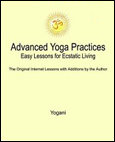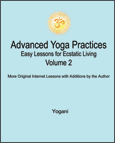|
Public Home | Plus Home | Main Lessons | Tantra Lessons | Public Forum | Plus Forum | Downloads | Books Topic Paths | Search | Training-Retreats | Testimonials | Survey | Interviews | MultiMedia | Contact | Donate |
|
Advanced Yoga Practices Note: For the Original Internet Lessons with additions, see the AYP Easy Lessons Books. For the Expanded and Interactive Internet Lessons, AYP Online Books, Audiobooks and more, see AYP Plus. Lesson 150 - Samyama Practice (Audio)
AYP Plus Additions:
From: Yogani New Visitors: It is recommended you read from the beginning of the web archive, as previous lessons are prerequisite to this one. The first lesson is, "Why This Discussion?"
Meditation is the process of bringing the attention inward to stillness,
inner silence, pure bliss consciousness, the witness state, samadhi. All of
these describe aspects of the same thing. We have a particular meditation
procedure that we do for set amount of time twice daily. It works like
clockwork and, over time, as we meditate each day and then go out and be
active, our nervous system becomes naturally accustomed to sustaining and
radiating inner silence. Our daily life then becomes calmer from the inside.
We are less overwhelmed by external events. This is the rise of the first
stage of enlightenment, which is inner silence present in our life
twenty-four hours a day, seven days a week.
Once we have some inner silence, even just a little, we have the opportunity to begin to operate from that level of infinite potential in us. All that exists is manifested from that, and we, being that, are capable of manifesting from that infinite reservoir of life within us. So, with our toe in the infinite, we can begin to move from there for the benefit our transformation to enlightenment. It is simple to do. You will recall that in meditation we use the thought of a sound with no meaning, the mantra, to systematically allow the mind to go to stillness. It is in letting go of any meaning, language or intellectual content, and just easily picking up the thought of the mantra, that are able to dive deep into pure bliss consciousness. The nervous system also goes to silence with the mind, and our metabolism slows way down. With samyama, we begin to go the other way. After our meditation time is up, we rest for a minute or two and we transition into samyama. We begin with an easy state of not thinking, just resting in our silence. If thoughts are coming, we just let them go without entertaining them. In samyama practice we do not entertain the mantra either. We start by not favoring anything but being easy in our silence, however much silence we have from our just completed meditation session, and naturally present in us from our months or years of daily meditation. This is the starting point for samyama -- silence. The only prerequisite for doing samyama practice is having some inner silence. For most people this is after a few months of daily deep meditation, as covered in the early lessons. Now we are ready to begin samyama practice. Here is how we do it. With samyama, we are initiating meaning in silence. We do it in a simple, easy, systematic way. First we create an impulse of meaning in silence, and then we let it go in silence. Let's begin with "Love." It is a good place to start with samyama. In samyama it is suggested you use your most intimate language, the language that goes deepest in your heart, whatever it may be. In your easy silence, pick up, just once, the fuzziest feeling of the word "Love" in your own language. Don't deliberately make a clear pronunciation, or mental images of this or that scene or situation that represent Love to you. Just have a faint remembrance of Love, and then let go into your silence, the easy silence you are in as you pick up the faint meaning of Love. Don't contemplate Love or analyze it during samyama. Don't think about it at all. Just come to it once in a faint, subtle way, and then let go into silence. It is a subtle feeling of Love we are coming to, nothing more, and letting it go. Like that. Having thought "Love" once, be in silence for about fifteen seconds. If any thoughts come, let them go easily. Don't look at the clock. With a little practice your inner clock will tell you with good enough accuracy when fifteen seconds is up. Just be easy in silence for about a quarter of a minute. Then pick up the faint, fuzzy meaning of "Love" again, and let it go again into your silence for about fifteen seconds again. That is two repetitions of samyama - twice picking up Love at its subtlest level of thought, and twice letting it go into inner silence. What is the effect of this? What will happen? To the extent we are picking up meaning on the border of inner silence (the subtlest level of thought), and then letting go easily into our silence, the effect will be very powerful. Inner silence is a huge amplifier of subtle thought. Inner silence is the only amplifier of thought. It is the source of thought. Usually our thoughts come out of silence stimulated by all that is lodged in our subconscious mind. So many habitual patterns are lodged in our obstructed subconscious mind, and these are what distort and weaken the flow of divine energy coming out from inner silence into our everyday life. With meditation we are clearing out the obstructions in the subconscious mind and developing a clear awareness of our inner silence. With samyama we are acting directly within our inner silence to produce an outflow of positive effects that purify our nervous system and surroundings in powerful ways. During samyama maybe we will feel some energy moving out from our silence. It can be experienced as physical, mental or emotional. Or maybe we won't feel much until later in activity, and then we are more loving and compassionate for no obvious external reason. We are changing from the inside. This is what samyama is - moving intentions from the divine level of silence in us out into external manifestation. Samyama is what prayer is when it is taken to its deepest level of communion with the divine inside us - taken within divine inner silence. Effective prayer is based on the principles of samyama we are discussing here. Each thought/meaning we use in samyama is called a "sutra." In sanskrit, sutra means, "to tie together, or to stitch." The English medical word, "suture" comes from sutra. In samyama, sutras are bits of meaning we give to unbounded pure bliss consciousness to amplify out into everyday life, to "tie together" our inner and outer life. So, sutras are bits of yoga we can consciously cultivate in ourselves through samyama practice. In the third chapter, or book, of Patanjali's Yoga Sutras on supernormal powers, many sutras are given for many different things. All this information is not for obtaining instant results or powers. If it were, it would not be doing anyone a favor in terms of gaining enlightenment. All those powers would be a great distraction to yoga if they were so easily obtained. Fortunately, as mentioned in the last lesson, samyama is morally a self-regulating practice, which means inner silence (samadhi) is the prerequisite for success in samyama. If there is inner silence, there will also be moral responsibility and conduct (yama and niyama), due to the connectedness of all the limbs of yoga. Samyama is having inner silence (samadhi), and the ability to pick up a thought (focus/dharana) and let it go inward (meditation/dhyana). Then the results of samyama come out from inner silence automatically. If we have the last three limbs of yoga, we will also have the other limbs, so powers from samyama will be divine in purpose. Even so, we should be clear about experiences versus practices, as always, and be mindful not to get caught up in experiences that come up. When experiences come up, we easily come back to the practice we are doing. As with all advanced yoga practices, the real benefits from samyama are to be found in long term daily practice of a particular routine of sutras. If we keep changing sutras around every day or week, and are irregular in our practice, the results will not accumulate. If we want to strike water, we will do best to keep digging in the same place. In advanced yoga practices we can do samyama after every meditation session before we go into yoni mudra kumbhaka (if doing that then) and our ending rest period. Samyama is a continuation of our meditation practice. First we are going in with meditation, and then we are coming out with samyama. For this purpose, a balanced series of nine sutras are given here. The suggestion is for each to be done for two cycles of samyama, two times with about fifteen seconds in silence for each sutra, and going straight through the list in order like that. In a few days they will be memorized and easy to navigate through using the method of samyama, going gradually deeper in practice with each session. The sutras are: Love Radiance Unity Health Strength Abundance Wisdom Inner Sensuality Akasha - Lightness of Air Each sutra is to be taken in its entirety, with the fifteen seconds in silence afterwards. For example, "Inner Sensuality" is a single sutra followed by fifteen seconds of silence. It is for pratyahara, introversion of senses. "Akasha - Lightness of Air" is also a single sutra, followed by fifteen seconds in silence. The meanings for the sutras can be translated to your deepest or first language, as discussed above. All except "Akasha," which is a sanskrit word meaning, "subtlest ether, inner space." We know from physics that we are ether, empty space inside, nothing really solid in here at all. Our body is that, and when we do samyama on "Akasha - Lightness of Air," we begin to feel very light. If you do each of these nine sutras twice in your samyama session, it will take about five minutes. If there is a particular one you feel the need to do more of, then add that on to the end and do samyama with it for another five minutes. The cycles remain at fifteen seconds, and we just keep going with that for five minutes, by the clock for that last five minutes. If there is no preference, then you can do the lightness sutra for five minutes at the end. It is very powerful. It is a mental kundalini technique that brings much energy up through the nervous system. It is not uncommon to experience physical symptoms such as panting (automatic bastrika pranayama) and "hopping" during samyama with the lightness sutra. If this happens, make sure you are sitting on a soft surface like a mattress. There can be various symptoms manifested with the other sutras as well. We are moving the infinite inner silence within us, so the manifestations coming out can be very real and noticeable. Patanjali calls these manifestations "supernormal powers," or "siddhis." For those who are full with bhakti for enlightenment, samyama repetitions can be increased to four for each sutra, and then ten minutes with a preferred sutra at the end (default is the lightness sutra). This is about twenty minutes of samyama practice. Make sure to take plenty of rest when coming out of your routine of practices, especially when doing samyama. Lying down for five or ten minutes at the end is good. As always, use self-pacing in your practices. Mental techniques such as meditation and samyama are very powerful, so to overdo them is to court uncomfortable energy flows. We each will find our comfortable limit through prudent self-pacing. Samyama greatly strengthens our presence in the silence of pure bliss consciousness. It promotes the integration of the inner and outer aspects of our nervous system. Samyama stimulates the nervous system to purify and open to the second and third stages of enlightenment, as well as enhancing our inner silence (first stage) in everyday life. Samyama makes the overall power of our desires much stronger. When we want to accomplish something that is in tune with the divine flow, resistance will be much less and obstacles will seem to melt away. For those who live in the silence of pure bliss consciousness and develop the habit of functioning naturally from that infinite level of life, a constant stream of "small miracles" becomes commonplace. Do samyama practice after your meditation for a few months and see for yourself. Samyama is more than a sitting practice. It is a way of thinking and doing that rises in our everyday life as we travel on the road to enlightenment. The guru is in you. Discuss this Lesson in the AYP Plus Support Forum Note: For detailed instructions on samyama practice, covering multiple applications, see the AYP Samyama book, and AYP Plus.
|
|
|
|
Join the Mail List:
AYP Retreats
eBooks - PDF, EPUB
FREE eBooks with
SAVE with Bundled
|

























